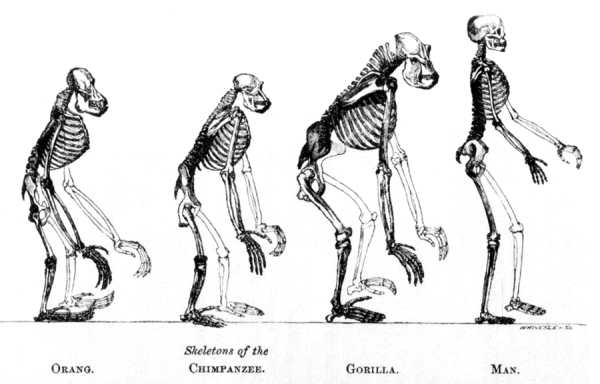Monogenism or Polygenism?: The Question of Human Origins
by Dr. Edward Feser
Filed under Anthropology, Evolution
NOTE: Today we finish our two part series by Dr. Edward Feser exploring questions about evolution, creation, faith, and human origins. You can read the first part here.
How can the doctrine of original sin be reconciled with what contemporary biology says about human origins? For the doctrine requires descent from a single original ancestor, whereas contemporary biologists hold that the genetic evidence indicates that modern humans descended from a population of at least several thousand individuals.
This is an issue I addressed a few years ago in a series of posts on my personal blog (here,here, and here). Longtime readers will recall that I there rehearsed a proposal developed by Mike Flynn and Kenneth Kemp to the effect that we need to distinguish the notion of a creature which is human in a strict metaphysical sense from that of a creature which is “human” merely in a looser, purely physiological sense. The latter sort of creature would be more or less just like us in its bodily attributes but would lack our intellectual powers, which are incorporeal. In short, it would lack a human soul. Hence, though genetically it would appear human, it would not be a rational animal and thus not be human in the strict metaphysical sense. Now, this physiologically “human” but non-rational sort of creature is essentially what Pius XII, John Paul II, and the philosophers and theologians quoted above have in mind when they speak of a scenario in which the human body arises via evolutionary processes.
The Flynn-Kemp proposal is this. Suppose evolutionary processes gave rise to a population of several thousand creatures of this non-rational but genetically and physiologically “human” sort. Suppose further that God infused rational souls into two of these creatures, thereby giving them our distinctive intellectual and volitional powers and making them truly human. Call this pair “Adam” and “Eve.” Adam and Eve have descendents, and God infuses into each of them rational souls of their own, so that they too are human in the strict metaphysical sense. Suppose that some of these descendents interbreed with creatures of the non-rational but genetically and physiologically “human” sort. The offspring that result would also have rational souls since they have Adam and Eve as ancestors (even if they also have non-rational creatures as ancestors). This interbreeding carries on for some time, but eventually the population of non-rational but genetically and physiologically “human” creatures dies out, leaving only those creatures who are human in the strict metaphysical sense.
On this scenario, the modern human population has the genes it does because it is descended from this group of several thousand individuals, initially only two of whom had rational or human souls. But only those later individuals who had this pair among their ancestors (even if they also had as ancestors members of the original group which did not have human souls) have descendents living today. In that sense, every modern human is both descended from an original population of several thousand and from an original pair. There is no contradiction, because the claim that modern humans are descended from an original pair does not entail that they received all their genes from that pair alone.
Of course, this is speculative. No one is claiming to know that this is actually what happened, or that Catholic teaching requires this specific scenario. The point is just that it shows, in a way consistent with what Catholic orthodoxy and Thomistic philosophy allow vis-à-vis evolution, that the genetic evidence is not in fact in conflict with the doctrine of original sin. Naturally other Catholics and Thomists might reasonably disagree with it.
Having said that, I have yet to see any plausible objections to the Flynn-Kemp scenario. This brings us back to Prof. Bonnette’s article. In response to the Flynn-Kemp proposal, he writes:
"The difficulty with any interbreeding solution (save, perhaps, in rare instances) is that it would place at the human race’s very beginning a severe impediment to its healthy growth and development. Natural law requires that marriage and procreation take place solely between a man and a woman, so that children are given proper role models for adult life. So too, even if the union between a true human and a subhuman primate were not merely transitory, but lasting, the defective parenting and role model of a parent who is not a true human being would introduce serious disorder in the proper functioning of the family and education of children. Hence, widespread interbreeding is not an acceptable solution to the problem of genetic diversity.
Moreover, given the marked reduction in the number of ancient HLA-DRB1 alleles found by the later genetic studies of Bergström and von Salomé, it may turn out that no interbreeding is needed at all, or at most, that very rare instances of it may have occurred. Such rare events might not even entail the consent of true human beings, since they could result from an attack by a subhuman male upon a non-consenting human female."
I put to one side Prof. Bonnette’s remarks about the genetic evidence, which I’ll leave to the biologists to evaluate. Bonnette allows that some interbreeding may have occurred, but he claims that it cannot have been “widespread” and that the reason has to do with natural law. But what is the problem, exactly?
Back in 2011, when Flynn, Kemp, and I first wrote on this topic and the Flynn-Kemp proposal was getting a lot of attention in the blogosphere, some people objected that interbreeding of the sort in question amounted to bestiality. But of course, no one is suggesting that we should approve of the interbreeding in question. The claim is merely that in fact it may have happened, even if this was contrary to natural and divine law (just as Cain killed Abel even though this was contrary to the natural law, and just as Adam and Eve ate of the fruit of the Tree of Knowledge, even though this was contrary to divine law).
Nor would it be a good objection to suggest that no one would plausibly have been tempted to engage in such interbreeding. After all, the scenario in question would hardly be comparable to that of the average member of contemporary civilization being tempted to have sex with an ape, which would of course not be psychologically plausible. For one thing, the sub-rational but genetically and physiologically “human” creatures in question would not be like apes, or indeed like any of the non-human animals with which we are familiar. They would more or less look like us. Furthermore, they would even act like us to some degree. As I noted in a recent post, though a purely material system could never in principle exhibit true rationality, it might simulate it to a significant extent (just as if you add enough sides to a polygon you will get something that looks like a circle even though it could not really be a circle). The sub-rational creatures in question would have been sphexish, but a sufficiently complex sphexish creature might seem not to be on a superficial examination. Recall Popper’s distinction between four functions of language: expressive, signaling, descriptive, and argumentative. The sub-rational creatures in question would not be capable of the latter two functions (which presuppose rationality) but they might have exhibited very sophisticated versions of the first two functions.
Meanwhile, the earliest true humans would not have had anything like the modern civilizational accompaniments of sexual activity, especially given the effects of original sin. Obviously it would be absurd to think of their liaisons as involving smooth techniques of romantic seduction, contemporary standards of personal hygiene, etc. So, the cultural “distance” between primitive true human beings and the sub-rational creatures in question need not have been so great as to make the sexual temptation psychologically implausible. It might have been comparable to a very uncultured and unsophisticated person taking sexual advantage of an even more unsophisticated and indeed very stupid person. Not that it wasexactly like that, since even a stupid person is still intelligent in the strict sense, whereas the sub-rational creatures in question wouldn’t even rise to the level of stupidity. The point is that the situation could have been psychologically close enough to that for the temptation to be real. (As I indicated, partly in jest, in one of the earlier posts, we might think on the model of Charlton Heston’s character “Taylor” being attracted to the Linda Harrison character “Nova” in Planet of the Apes -- not that the early sub-rational creatures would have looked quite that good!)
It doesn’t seem that the “bestiality” issue per se is really the heart of Prof. Bonnette’s objection, though. His point seems instead to be that a “union” of a true human being with a sub-rational creature of the sort in question would be dysfunctional vis-à-vis the proper rearing of truly human children. This is true, but it is hard to see how it is a problem for the Flynn-Kemp scenario, for nothing in that scenario requires that such “unions” be anywhere close to optimal from a child-rearing point of view, or even that there be “unions” (of some long-term sort) in the first place. All that it requires is that there was enough interbreeding to account for the genetic evidence appealed to by contemporary biologists. It isn’t clear how the question of whether, how, and to what extent the sub-rational creatures were involved in child-rearing affects the judgment that there was sufficient interbreeding.
Perhaps Bonnette thinks that child-rearing would have been so deficient that the population of true humans could not have survived long enough to displace the sub-rational creatures. But it is hard to see why. Surely the child of a “union” between a true human being and one of the sub-rational creatures would have an advantage over the offspring of two sub-rational creatures, for such a child would itself have rationality and at least one rational parent, whereas the other sort of offspring would have neither. Moreover, we needn’t think in terms of such pairings in the first place. Why not think instead of a scenario where a truly human male forms a union with a truly human female but also has several sub-rational but genetically and physiologically “human” females as concubines, where the resulting children are all essentially reared by the human couple? And such arrangements need only have occurred frequently enough for the truly human population to supplant the population of sub-rational creatures. There is no need to flesh out the Flynn-Kemp scenario in the specific way Bonnette (apparently) does.
So, it seems to me that neither Prof. Bonnette nor anyone else has raised any serious difficulty for the Flynn-Kemp proposal. However, Prof. Bonnette is right to hold that many Catholics need to show greater caution when commenting on matters pertaining to evolution.
Related Posts
Note: Our goal is to cultivate serious and respectful dialogue. While it's OK to disagree—even encouraged!—any snarky, offensive, or off-topic comments will be deleted. Before commenting please read the Commenting Rules and Tips. If you're having trouble commenting, read the Commenting Instructions.













